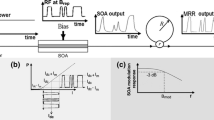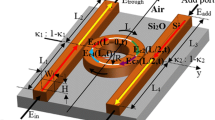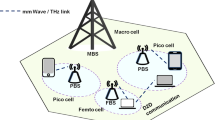Abstract
In this paper, we analyse the picosecond wavelength conversion using semiconductor optical amplifier (SOA) with a novel technique. For an accurate and precise modelling, all the nonlinear effects that are relevant to picosecond and subpicosecond pulse regime, such as, self-phase modulation, nonlinear Kerr effect, spectral hole burning, carrier heating, carrier depletion, two-photon absorption and group velocity dispersion are taken into account in the SOA model. We integrate the structure with a microring resonator notch filter to eliminate the unwanted pump and probe signals at the output of the system. It shows that with the three coupled microring resonators, output four-wave mixing (FWM) signal generated by the SOA can be filtered accurately. Moreover, our results demonstrate that the microring resonator can be used for modifying the shape and spectrum of the output FWM signal. Simulation results show that this new technique enhances the output time bandwidth product.
Similar content being viewed by others
References
Connelly M.J.: Semiconductor Optical Amplifiers. Kluwer, Boston, MA (2002)
Das N.K., Yamayoshi Y., Kawaguchi H.: Analysis of basic four-wave mixing characteristics in a semiconductor optical amplifier by the finite-difference beam propagation method. IEEE J. Quantum Electron. 36(10), 1184–1192 (2000)
Gandomkar M., Ahmadi V.: Design and analysis of enhanced second harmonic generation in AlGaAs/AlO x microring waveguide. Opt. Express 19, 9408–9418 (2011)
Hagness, H.C.: FDTD computational electromagnetics modeling of microcavity lasers and resonant optical structures. PhD thesis Dissertation, Illinois, USA, Northwestern University (1998)
Little B.E., Chu S.T., Haus H.A., Foresi J., Laine J.P.: Microring resonator channel dropping filters. J. Lightw. Technol. 15, 998–1005 (1997)
Meuer C. et al.: 80 Gb/s wavelength conversion using a quantum-dot semiconductor optical amplifier and optical filtering. Opt. Express 19, 5134–5142 (2011)
Razaghi M., Ahmadi V., Connelly M.J.: Comprehensive finite-difference time-dependent beam propagation model of counterpropagating picosecond pulses in a semiconductor optical amplifier. IEEE/OSA J. Lightw. Technol. 27(15), 3162–3174 (2009)
Razaghi M., Ahmadi V., Connelly M.J.: Femtosecond pulse shaping using counter-propagating pulses in a semiconductor optical amplifier. Opt. Quantum Electron. (Springer) 41, 513–523 (2009)
Author information
Authors and Affiliations
Corresponding author
Rights and permissions
About this article
Cite this article
Razaghi, M., Gandomkar, M., Ahmadi, V. et al. Picosecond wavelength conversion using semiconductor optical amplifier integrated with microring resonator notch filter. Opt Quant Electron 44, 255–263 (2012). https://doi.org/10.1007/s11082-012-9543-6
Received:
Accepted:
Published:
Issue Date:
DOI: https://doi.org/10.1007/s11082-012-9543-6




